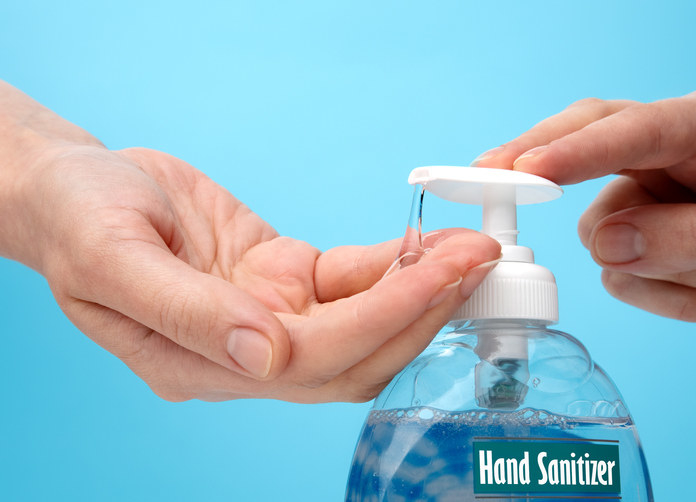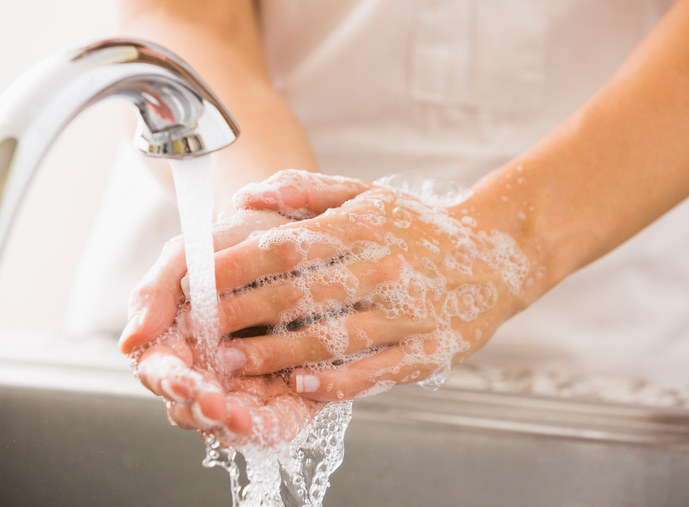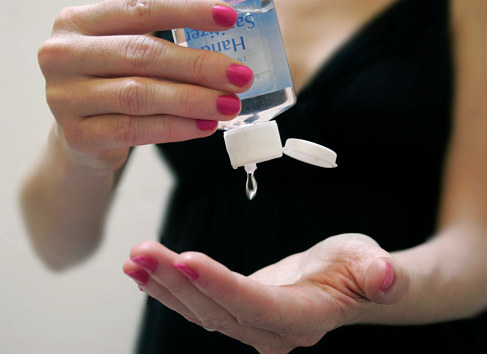The debate between hand sanitizer and handwashing is surprisingly...heated.
Between Twitter, various comment sections, and conversations I’ve overheard on the New York City subway, there seem to be a lot of strong opinions when it comes to the best hand hygiene method. Some people say that washing your hands is better and others vouch for sanitizer, because nobody washes their hands properly. But what is actually the best way to clean your hands and protect yourself against germs that can make you sick?
We reached out to two germ experts to find out which method is really better and why.
We spoke to Kelly Reynolds, germ expert and associate professor of environmental health at the University of Arizona, and Jason Tetro, visiting scientist at the University of Guelph and author of the best-selling book Germ Files.
First of all, not all hand sanitizers are equal.

There are a million different kinds of hand sanitizer: gels, foams, alcohol-based, all-natural, ones that smell like pumpkin spice, and more. And it turns out, the type of sanitizer really does matter — or rather, the active ingredient and its concentration, says Reynolds.
"You'll want a hand sanitizer that's 62–70% ethyl alcohol," said Tetro. Most of the popular brands out these days, like Purell, have 70%. When it comes to the alcohol-free stuff with ~natural active ingredients~ like aloe vera, the experts say they might kill some germs but definitely not enough. In order for a sanitizer to be effective, it has to reduce a certain amount of microbes from a surface. "The goal is a four-log (or 10,000-fold) reduction, meaning it reduces about 99.99% of the germs on your hands — and that's enough to prevent illness," said Reynolds.
So it doesn't really matter which brand of hand sanitizer you use or whether it's gel or foam, as long as it has at least 60% alcohol. And you should use enough hand sanitizer so that your hands get wet and it takes about 15 to 20 seconds for them to dry, says Tetro.
Alcohol-based hand sanitizers are effective at killing most stuff, including cold and flu germs — but not everything.
Hand sanitizer is pretty effective, but alcohol-based sanitizers don't kill everything, Reynolds says, such as the highly contagious stomach bug norovirus, some parasites like Giardia, and the diarrhea-causing bacterium Clostridium difficile.
They just don't get broken down and killed by the alcohol compounds in sanitizer like other germs do. The good news is that you are less likely to encounter these pathogens — unless you work in a hospital, where C. difficile is spread easily. "People are usually more concerned about cold and flu viruses, and those are killed with alcohol-based hand sanitizers," Reynolds said. But if you have any visible dirt or grime or sticky stuff on your hands, the sanitizer probably won't remove it, which is not ideal.
So washing your hands with soap and water is the best hygiene method because it gets rid of more germs AND dirt, debris, and grime.
So there you have it: Proper handwashing is the gold standard. Why is it better than hand sanitizer? "Data show that they’re both effective at reducing germs, but handwashing actually kills germs, but it also physically removes much dirt, debris, and spores that could make you sick," Reynolds said. So in contrast to hand sanitizer, washing your hands does remove those pathogens like norovirus, Giardia, and C. difficile.
"Again, it's not the soap alone that kills the germs — but the friction of lathering and washing away the organisms that makes handwashing more effective," Reynolds said. Washing with soap has been shown to be better than washing with water alone because it loosens the germs’ ability to grip to the hands, making them easier to rinse away.
BUT, you need to wash your hands properly — which means lathering with soap for 20 seconds.

"Proper handwashing with soap and water is probably the best thing you can do, but most people don’t wash their hands properly," Reynolds said. So here’s how to do it the right way:
1. Run your hands under clean, running water (hot or cold).
2. Lather up your hands and fingers with soap.
3. Scrub for 20 seconds (or as long as it takes to sing the "Happy Birthday" song twice).
4. Rinse your hands with clean water.
5. Dry your hands completely using a clean towel, a dryer, or let them air-dry.
"People don't think about it, but hand drying is a very important step — if your hands are still wet, you will pick up and transmit germs very easily," Reynolds said. So don’t leave with wet hands or just wipe them on your pants — air-drying is better if you don't have a clean towel.
Also, any soap will work as long as it lathers and successfully washes off the dirt and grime, says Tetro. Antibacterial soap doesn't have any added benefit, and may actually promote antibiotic-resistant germs. In fact, one of the most common active ingredients marketed as antibacterial, triclosan, has been banned by the FDA for use in hand soaps and body washes (although it can be found in other products) because it’s not clear if it’s safe for everyday use and has been shown to be no more effective than regular soap at preventing illness.
But hand sanitizer is still a good option if you can't wash your hands in the moment or you don’t have access to clean water.
"Hand sanitizers have made their way into health care environments for a reason — they're quick, easy, and effective if handwashing isn't an option at that moment," Reynolds said. And they are great to use on your way out of places where you'd pick up germs — like a subway, portable toilet, or petting zoo.
And of course, hand sanitizer is great if you're in a place where you don't have access to clean, running water, says Tetro. So keeping a little tube when you're traveling, especially in developing countries, is a great strategy to avoid disease. The only real downside of hand sanitizer is that it can really dry out your hands and lead to irritation if you use it frequently or your skin is sensitive, says Reynolds.
And yes, hand sanitizer does "kill the good bacteria" on your hands — but there's no evidence that this is bad for your health.

You might've heard that you shouldn't use hand sanitizer because it kills all of the good bacteria on your hands, which could be bad for your health because these bacteria help protect you. "Sure, it does kill the good bacteria, but there is no evidence that this actually leads to any adverse health effects, and the good bacteria will repopulate immediately if you just touch your arms or your hair or another part of your body," said Reynolds.
What matters is that you remove any bad germs that have the potential to cause disease — that has the biggest impact in terms of your health. "The argument that it destroys the microbiome is pretty much and null and void," Tetro said.
Bottom line: Keeping your hands clean — whether that's through sanitizer or washing — will help prevent illness and keep you healthy.
Germs are everywhere and you'll get exposed to them no matter what you do. But you do want to try to avoid the germs that can make you sick. And our hands are a vehicle for those germs to travel from a surface into our body — whether they're from the bathroom, a subway handrail, raw food, your computer keyboard, etc. "We have so much evidence that handwashing reduces illness — it has a measurable health benefit and it's very important for preventing the spread of disease, especially in health care facilities, offices, schools, etc.," Reynolds said.
So, wash your hands before you eat or prepare food (particularly when handling raw meat), touch your face, touch a baby, or treat a cut or wound. Wash them after you use the bathroom, change a diaper, blow your nose or sneeze, touch garbage, prepare food, pet an animal, or if your hands have any visible dirt.
